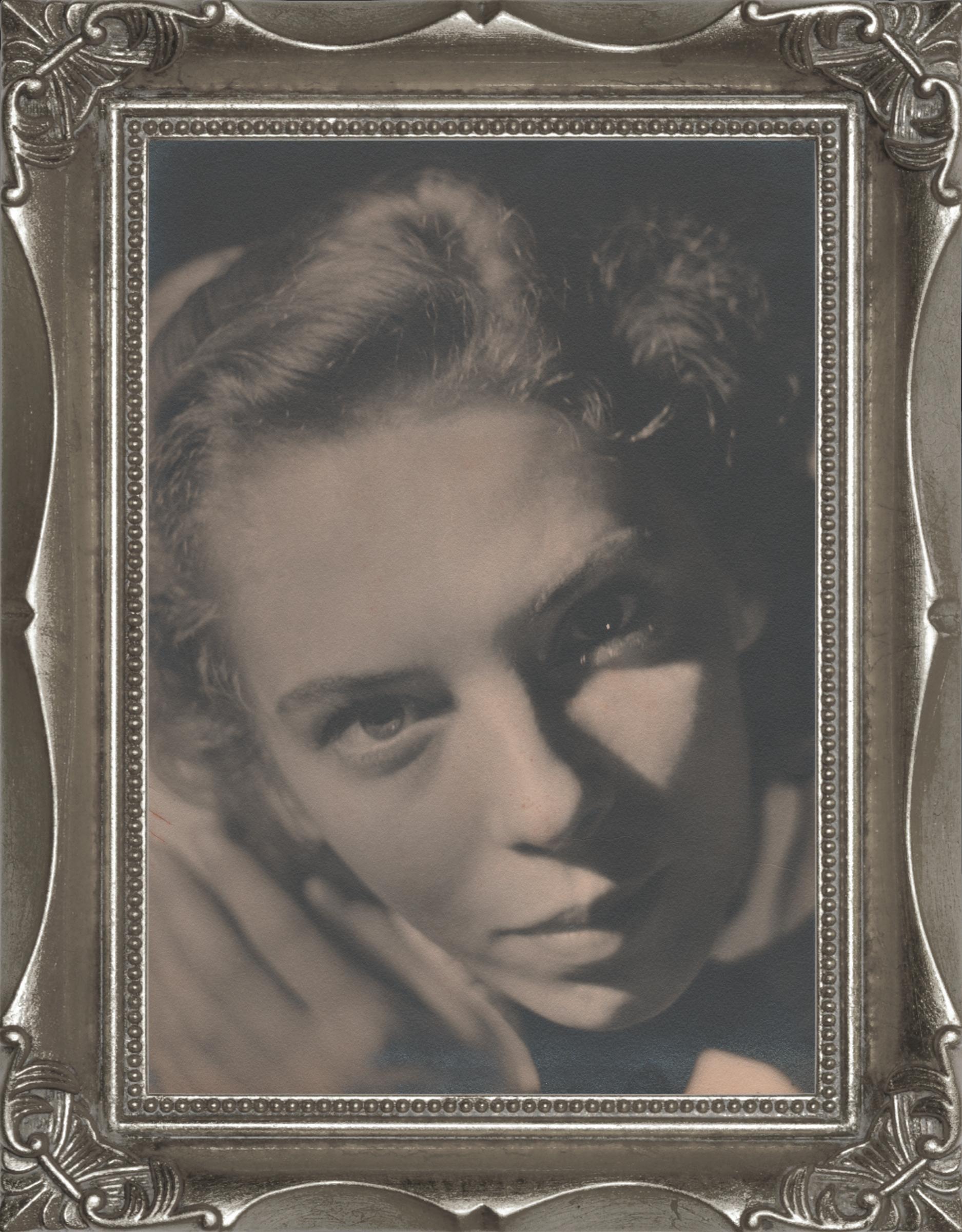
13 minute read
Harriet Muller Paintings
Advertisement
Born in Dalton, Pennsylvania in 1911 to Drucilla, a milliner, and Walter Crothamel, an engineer, Harriet had an older brother, Bob and a younger sister, Jean She was raised during a time of the extended family, and her grandfather, Jackie, who was a coal man for Casey Jones, and a bit of a drinker until prohibition, clearly treated Harriet as his favorite .
To bring income into the household, Jakie kept a coop behind the house for the raising and selling of chickens and their eggs to the neighbors . Harriet, who always carried a piece of chalk with her so that she could ‘doodle,’ often created mischief with that simple piece of chalk . One of her favorite pastimes was to draw a line on the chicken coop floor and place each of the chickens’,
beak down on the line, neatly in a row Not only did this hypnotize the birds, it also interrupted their laying . Luckily, Jakie saw the tomfoolery as being all in fun, and Harriet would be sent on her way to amuse herself elsewhere .
All kidding aside, it was apparent at an early age that Harriet possessed the eye and hand to be an artist Throughout her life she created her art on anything that was available when the mood struck her . In the typical fashion of many true artists, her canvas became anything that was readily available to her for creating a sketch of what would become a painting, including newspapers, the backs of envelopes and magazine covers, using several mediums including pencil, chalk, pastels and oil paint .
Not only was Harriet an artist, but also an actress . In June 1932, as part of the little theater group in her hometown of Lincoln Park, New Jersey, the Garrett Players, she not only assisted
in designing and creating the stage sets for the play Daddy Long Legs, she also played the lead role of Judith Abbott, while her sister, Jean, played the role of Julia Pennington . Also involved in the production were her life-long friend, Gene Fenn, and her future husband, Robert Crowell .
As a high school senior of the class of 1930, Harriet was the Boonton High’s yearbook artist Accepting opportunities as they came her way, Harriet also took a part-time job assisting the local photographer with his studio work, which further nurtured her creativity . With an incredible sense of imagery, she seemed to see art in most anything Once while living in her niece’s trailer, she decided the water stains that had formed on the ceiling resembled ducks, and thus she painted them into a school of swimming ducks .
In the fall of 1933, yet another opportunity came her way, that of attending the prestigious New York City art school, The Cooper Union for the Advancement of Science and Art Encouraged by her friend, Gene Fenn, who was also an artist, they attended the school together Fenn, who became one of New York’s foremost fashion photographers in the 1940’s, even photographed Harriet’s daughter, Jean, when she was a toddler In 1949 Fenn moved to Paris to study and paint, but continued with his photography, documenting key artists of the time including Chagall and Picasso . Though a continent apart, he and Harriet remained friends into their late 80’s, with Harriet visiting him three times in Paris, and he each year sending her his personalized Christmas or New Year’s cards . Following his death in 2001, much of Fenn’s work was auctioned at Christie’s of New York .
In her free time Harriet worked at her art in her parent’s attic, beginning with a pastel portrait of her young daughter, Jean, as well as sketching
landscapes with a special emphasis on flowers
In the summer of 1942, during WWII, Harriet accepted a job with Curtiss-Wright Aeronautical where she designed tools and wrote manuals for use by pilots in the field to allow them to repair their own airplane engines . The company is famed for supplying the Wright Whirlwind J5 engine that was used

With artist and lifelong friend, Gene Fenn in Paris, 1985.

Harriet ss a freshman at Cooper Union, 1933.
to power Charles Lindbergh’s “Spirit of St . Louis .” Part of the requirements of her job was to tear down and then rebuild an airplane engine to ensure that the tools and the manual could be put to use in the field and would serve our fly-boys with excellence To prepare her for the position, she attended a War Training Program, run by the then Dept of War In an accelerated course, she logged 397 hours of class time in less than three months to receive a Certificate in Introduction to Engineering from Newark College of Engineering, which, during that time catered to an all male student-body .
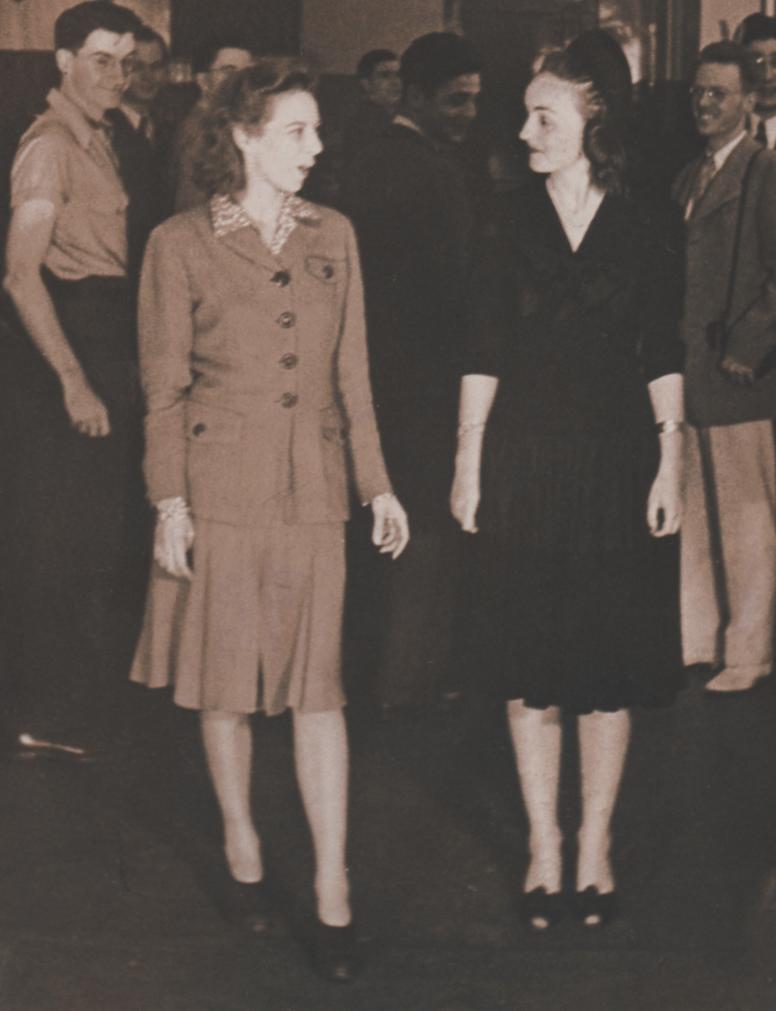
In 1951 Harriet fulfilled her dream of moving to Alaska, which at the time was but a territory . The trip was a tale unto itself, beginning with a crosscountry drive to Seattle and ending with she and Jean on a cargo plane with a few GI’s and a load of bananas, flying to Anchorage Once there Harriet worked nights a local bakery and spent her days

drawing upon the wonders that surrounded her and created many wildlife scenes and landscapes . Typical of life in Alaska at that time, they lived meagerly, but that didn’t stop Harriet from thriving as an artist, which perhaps even lent itself to her enthusiasm to remain As the campaign for settlers continued, Harriet’s sister, Jean also came to Alaska with her son and husband in late 1951, staying until

On the Alcan Highway. L-R Harriet’s 4th husband, Otto, daughter, Jean, Harriet (in car), her sister, Jean, with her son, Roger, 1953.

With her dog, Wolf, at Portage Glacier, Alaska, 1956.
1955 As well, Harriet’s daughter, Jean, remained in Alaska for 20 years, giving birth to all three of her children there .
In 1964 Harriet began studying portraiture with renowned artist Wassily Sommer . Sommer, a Russian immigrant, was a cellist, painter and educator at the University of Alaska He saw great potential in Harriet’s work and encouraged, as well as challenged her to perfect her craft . The two orchestral paintings were done as an assignment from Sommer’s class, as he was also a member of the Anchorage Orchestra . It wasn’t realized until the recent cataloging of Harriet’s work that she had created two Orchestra: The String Section paintings The original, which was painted on masonite, was discovered wrapped in paper and stored in a closet . The second, that has hung, neatly framed in her daughter’s home for years, was painted on a lar ger canvas .
After having relocated her elderly parents to Tarpon Springs in 1959, Harriet made a good many trips between then and 1972, dividing her time to family in Florida, New Jersey and Alaska
Once Harriet settled again, it was Tarpon Springs, the Sponge Docks and the surrounding
area in which she found new subject matter for her work .
For those who remember Bill’s Lighthouse, it was Harriet’s painting of the sponge diver’s that hung just inside the restaurant’s front entrance .
Continuing her fascination of sponge divers, she created two nearly identical pastel renderings of a traditional sponge diver in fully suited gear working a midst an array of colorful and curious fish as he collects live sponges and deposits them in his bag . As well, Harriet also created new signage for Zorba’s restaurant and bar, as is depicted in her original sketches which are on display at the art exhibit .
World Traveler
For a decade Harriet celebrated her birthdays on fabulous adventures, beginning with a trip to Honduras at the age of 66 . In 1978 it was off to Europe, where she saw Spain, England, France,
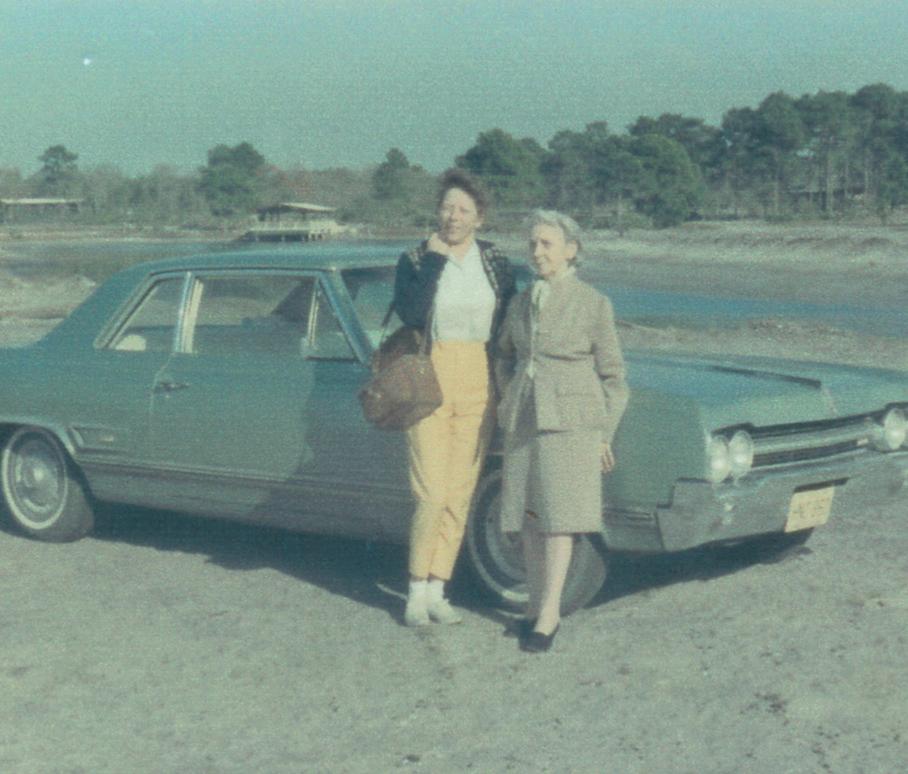
With her mother, Drucilla, in Florida, 1959.
and took a side trip to Morocco where she rode a camel on her 67th birthday .
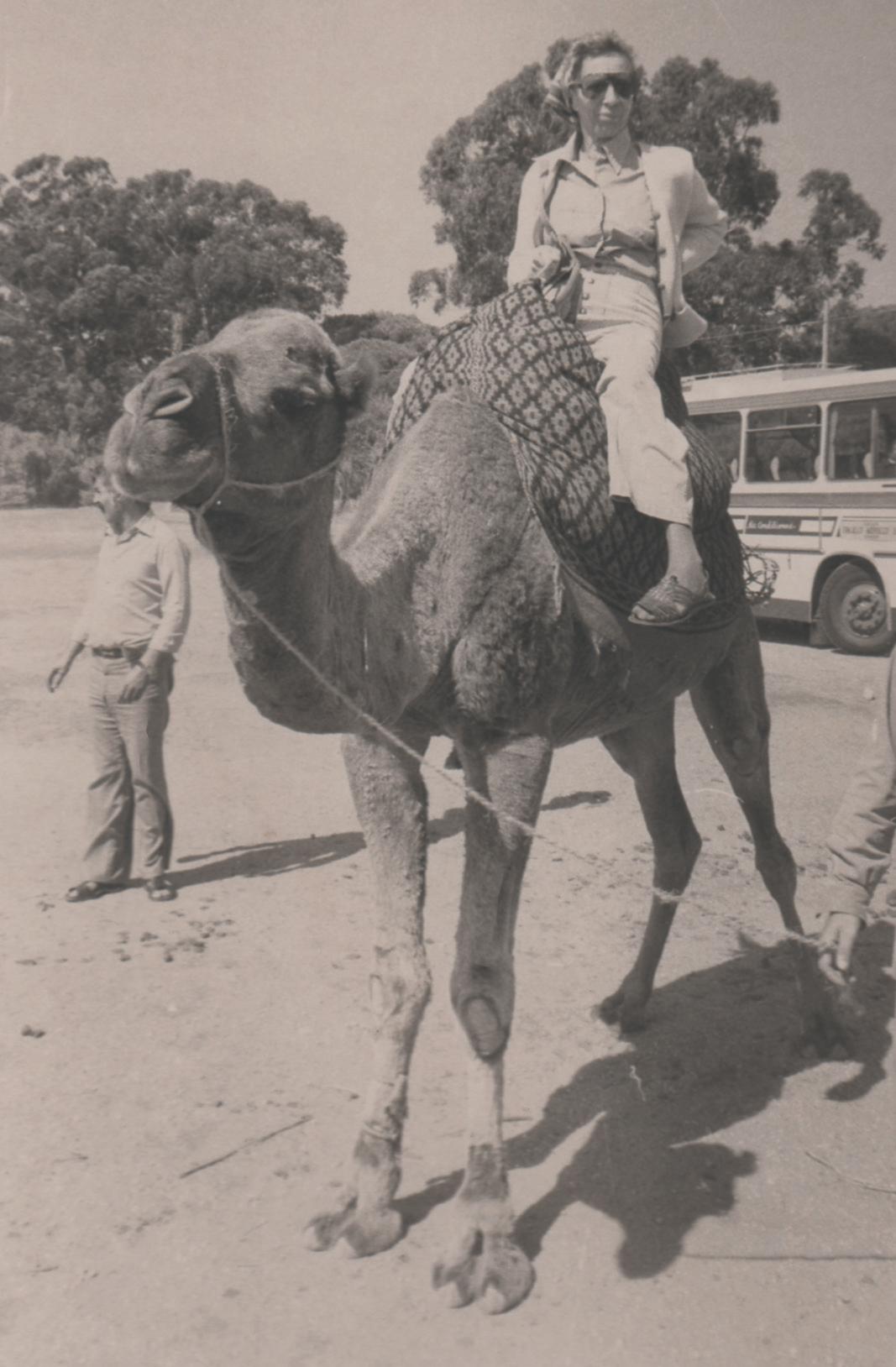
Moroccan camel ride, 1978.
For her next trip, in 1979, she was excited to see Italy However, at the last minute decided not only to take her granddaughter, Gabrielle along, but also, to expand the trip to an 18-day excursion of Austria, England, France, Germany, Holland, Italy, and Switzerland . It was an exciting trip for both, and unearthed in Gabrielle that incredible sense of adventure that had so driven her grandmother for the whole of her life

With granddaughter, Gabrielle in Innsbruck, Austria, 1979.
In 1981, India was the next stop on Harriet’s world tour, where she marveled at the people and the architecture The brightly colored clothing, art and buildings were awe-inspiring to her . Clearly a tourist, Harriet’s curious and friendly demeanor

Snake handling in Bangkok, 1980.

Water buffalo ride, Indonesia, 1980.
made her welcomed among those she met, and of course, she had her birthday ride, this time atop an elephant

Atop an elephant in India, 1981.

Gathered with local women, India, 1981.
At the age of 71, it was off to Africa on safari . Harriet’s stories of being out in the field and witnessing first hand, the bold, beautiful creatures of that region in their natural element, completely unaffected by human presence was amazing to her . She described nights in her tent hearing the movements and sounds of wild animals in the darkness and watching a kill take place out on the open plain during the daylight hours . Her pastel rendering of a male lion, lying in the deep grass was taken from one of the many photographs of that trip .
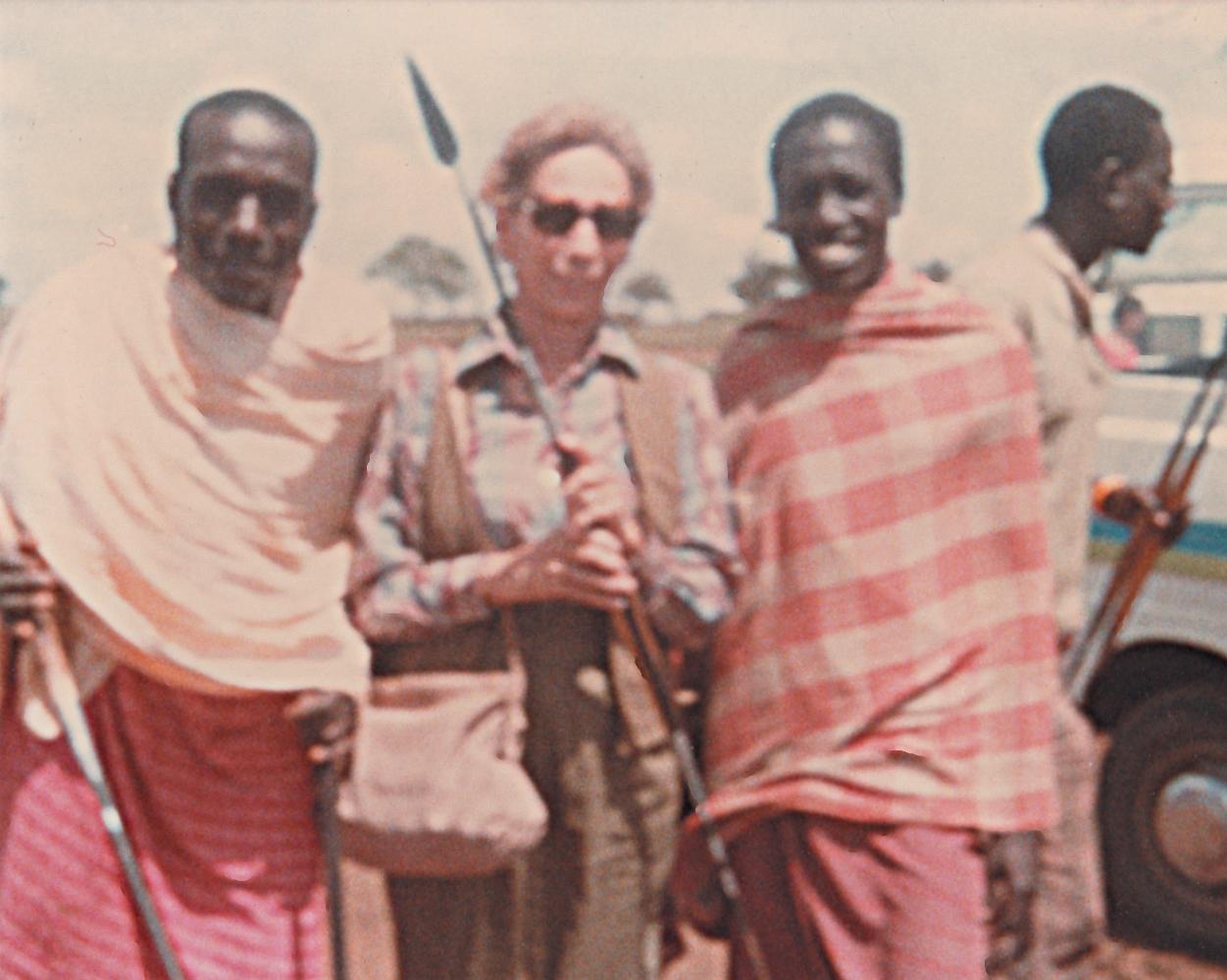
With tribesmen in Kenya, 1982.

On safari in Africa, 1982.

Celebrating her 72nd birthday, Alaska, 1983.
Alaska bound, again, this time to the Aleutian Island of Sand Point; Harriet was off to visit her grandsons, Lynn and Dale, for her 72nd birthday . Never having been to this remote region of the state, she marveled at the life her grandsons had built for themselves as fishermen performing the most dangerous of jobs in the world in the most treacherous bodies of water in the world, the Bering Sea .
A very exciting trip was planned in 1985, as Harriet and her daughter Jean made their first trip together to another continent . This being Jean’s first trip to Europe, it was an even greater thrill to Harriet to be sharing this adventure with her . They went to France, and of course, to Paris to see Gene Fenn, who had not seen Jean since she was a small child . Then it was on to Italy, and from there, to Greece where they walked among the ancient ruins of the Parthenon and the Coliseum in Athens . Highlights of the trip included a donkey ride on the island of Santorini, which took them on a trek up the long stairway to the town of Fira that lies on the rim of the volcano around which the island is built As well, they visited the ancient city of Ephesus in

With her daughter, Paris, 1985.

Taking the donkey ride in Santorini, 1985.
Turkey where Harriet jokingly perched upon one of the multi-seated community toilets of the time that are still found there
In 1986, at the age of 75, Harriet retired from her job as a nurse’s aide at Anclote Manor Hospital . With that, she made one more trip to Sand Point, Alaska, where, at that time, all three of her grandchildren now lived, as well as the new arrival of her first great-grandchild, Lynn, Jr It was on this trip that the beauty and wonder of the wild surroundings gave way to Harriet’s paintings of Squaw Harbor, The Pilings and Salmon Season.
When Harriet retired from her job at the hospital, her friend and life-long admirer, Burns Kurtz invited her to spend time at his home in New York, near the Pocono’s Harriet’s return to familiar surroundings re-energized her creative appetite, as she took in the many picturesque sights of the
area . Paintings from this time include Milkweed, The Butcher’s Shop, and The Stone Arch Bridge.
As she was only an hour from her childhood home of Clark’s Summit, Pennsylvania, she spent many afternoons visiting her best friend since pre-school, Emily Lutz . Both were high-spirited throughout their lives and found fun whenever they were together
1n 1989 Harriet made her first land purchase Finding her place in north Florida, she built her dream home in Old Town and settled there in 1990, with her two dogs, her two acres of wooded bliss and her art . With a place of her very own, she created portraits of the members of her family both

On the back deck of a fishing boat, Alaska, 1986.
.

The cabin she designed and built. The first home she ever owned, Florida, 1990.
living and dead, unearthed decade’s old newspaper clippings of wildlife and scenery she thought would someday make nice paintings, as well as capturing
on canvas the images she photographed during her travels around the world .
It should be noted that Harriet especially liked the works of the great impressionist painters Claude Monet and Pierre-Auguste Renoir Her styling in several of her own paintings is reflective of impressionism In viewing many of her landscapes, they become more clearly focused to the eye when the observer stands a few feet back and takes in the entire depth and scope of the scene
At the age of 81 she successfully fought cancer and managed to return to her life in the woods . However, by the age of 89 her free spirit and creativity were stolen from her by the affects of Alzheimer’s . Although until her 94th birthday, there were those days when that bright, humorous, mischievous spirit that was so Harriet did shine through .
It is the hope of Harriet’s family that her art will be enjoyed and looked upon as an extension of her – a strong, adventurous woman who loved her family and made the most of all that life had to offer

Working at home on one of her very last paintings, 1999.

